Table Of Contents
<!-- TODO FIXME: add OnHover HoverImage Component here -->
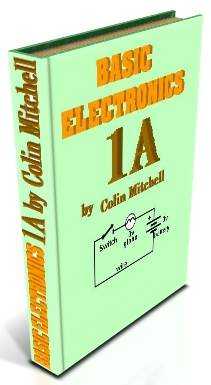
Contents of Article
- Page 1: Basic Electronics
- The capacitor - how it works
- The Diode - how the diode works
- Every Circuit Symbols
- Soldering Videos
- Page 2: The Transistor
- PNP or NPN
- Transistor TEST
- Page 2a: The 555 IC
- Page 3: The Power Supply
- Page 4: Digital Electronics
- Page 5: Oscillators
- Page 6: Basic Electronics 50 Questions Test
- Page 7: using The Multimeter
- Page 8: Constructing a Project
- Page 9: Inductance
INDEX
- Inductance
- 3 pole DC Motor
- See our article on the INDUCTOR
INDUCTANCE is what an INDUCTOR has. It has INDUCTANCE. It has the ability to store energy in the form of magnetic flux and this energy can be stored in the CORE (the MAGNETIC CORE). Inductance is measured in Henry (H) , milli-Henry (mH) and micro-Henry (uH). An INDUCTOR is a coil of wire and it may be wound on a plastic former called a BOBBIN and the centre of the bobbin can be filled with a magnetic material called a CORE or MAGNETIC CIRCUIT. Inductance is a unit of storage, just like a battery has a storage of amp-hours.
INDUCTANCE
We are talking about how much energy can be stored by a coil of wire, called an INDUCTOR.
It has the units of: Henry (H) , milli-Henry (mH) and micro-Henry (uH).
But our discussion starts with a length of wire.
An amazing thing that happens when it is connected to a battery.
When a current flows through a piece of wire it produces magnetic flux.
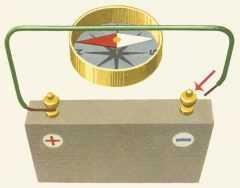
You can see this effect by placing a wire over a compass - the needle moves slightly.
To increase the movement of the needle, lots of turns of wire are wound on a cardboard tube (called a former).
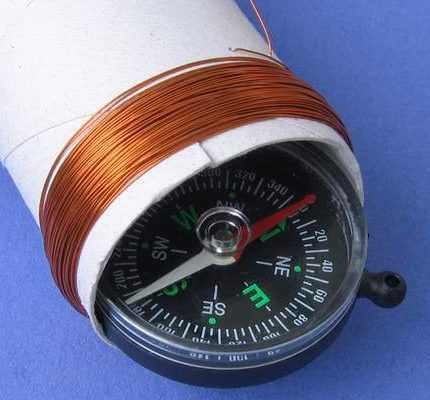
By increasing the number of turns, the needle will rotate more.
Don’t worry about which way it rotates or how much it rotates, the needle shows magnetic flux is being produced by the coil.
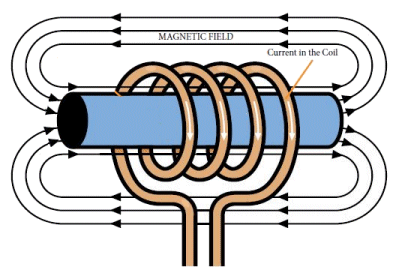
This is how we draw the magnetic lines produced by the current in the coil. The lines emerge from one end of the rod, pass around the outside and enter the other end.
These lines make it easy to describe what is occurring.
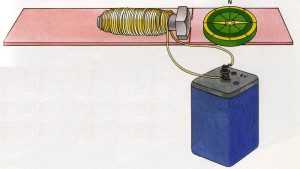
By winding the coil on a nail, screw or bolt, the magnetic flux from each turn is added together (called concentrated) and comes out the end of the bolt.
These experiments were demonstrated over 100 years ago and everyone thought they were amazing.
It was the first time electricity had an effect on moving an object.
Now we come to something that is more amazing.
When the switch is closed (called a knife switch), the compass needle moves slightly clockwise and then returns to “North.”
When the switch is opened, the needle moves anti-clockwise and returns to “North.” The “up-down” position of the needle is simply to set it so it can move clockwise and anticlockwise.

When this was demonstrated over 100 years ago, there was no other test equipment and the demonstrator Michael Faraday concluded that voltage was induced in the compass coil - in one direction - when the switch was closed and induced in the other direction when the switch was opened. The two coils did not touch each other and the only thing connecting them was magnetic flux through the ring. (the ring is called a ferrite ring or fine powered iron ring.)
This is also shown in the following two diagrams:
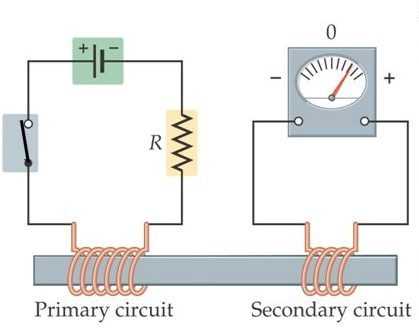
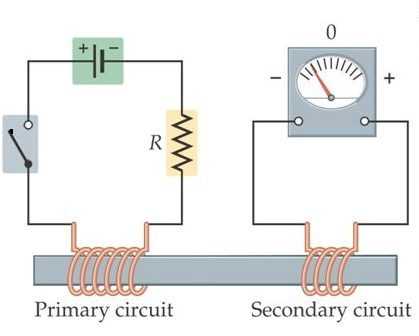
Here’s the next amazing feature.
When you turn off a circuit containing a coil, a very high voltage appears across the ends of the coil.
You can feel this by connecting 12v to a relay and hold the wires in your two hands. When you remove the wires, you will feel a zap.
You can also connect the relay as shown in the diagram below so is buzzes when the voltage is applied. Feel the terminals by pressing firmly with your fingers and you will get a zap.

This means the 12v is converted to at least 80v to give you a zap.
How does this happen???
The relay contains a coil of thousands of turns.
When you connect the supply, the coil produces magnetic flux (commonly called magnetism).
When you remove the supply, the magnetic flux collapses and cuts all the turns of the coil and produces a very high voltage IN THE OPPOSITE DIRECTION.
This means a coil has 2 uses. It can deflect a compass needle or pick up nails or scrap metal to load into a ship etc or it can be used for its ability to produce a high voltage.
The first is called its DC use - as an electromagnet and the second is its AC use as an INDUCTOR.
We will be discussing its AC use (its use in AC circuits). AC circuits are circuits with a signal - a frequency.
We are not going to produce a high voltage but we are interested in the fact that a voltage is generated IN THE OPPOSITE DIRECTION to the supply voltage.
This “zap” voltage is only generated (produced) when the supply is turned OFF or if the voltage reduces quickly.
If the voltage reduces quickly, this voltage is very high.
The voltage has a name: It is called BACK EMF. (It can also be called FLYBACK VOLTAGE).
Let us go even further.
When an increasing voltage is delivered to the coil, the magnetic flux produced by each of the turns, cuts each of the other turns and produces a voltage in the opposite direction.
That’s right. You can imagine the complexity.
Each turn is producing magnetic flux and this flux passes each of the other turns and produces a very small voltage in each turn that is opposite to the supply.
This is the end result: The supply might be 12v and the back voltage can be as high as 11.9v
This means the effective forward voltage is only 0.1v and by using Ohm’s Law, the current flowing through the coil will be very small.
This effect only occurs when the voltage is rising and falling.
When the current is steady, the coil is simply an electromagnet, such as a magnet to pick up pins or nails and we are not concerned about this state.
When the voltage is rising, the current is increasing and the flux is increasing. This is called EXPANDING FLUX.
When the voltage is decreasing, the current is decreasing and the flux is called COLLAPSING FLUX.
This means there is a voltage and current opposing a voltage being delivered to a coil and this reduces the current flowing into the coil.
Thus a coil behaves completely differently when a rising and falling voltage is delivered to it.
And that is what we are going to cover.
When an AC voltage is applied to a coil, the turns produce a back voltage that reduces the current entering the coil. This effect is like “pushing against” the current trying to enter the coil and technically we say the current is IMPEDED - PREVENTED - REDUCED.
In other words, the coil has IMPEDANCE.
Impedance has the units of OHMS but it is not obtained via an Ohmmeter.
Impedance is a calculated value and we will give a simple example:
Suppose a coil takes 3 amps when connected to a 12v supply. This is the case of the coil being an electromagnet and the resistance is 4 ohms.
But when an AC signal is applied, the average current is just 1 amp. (This is because the coil is creating a back voltage and because the resulting forward voltage is very small, only a small current flows).
by using Ohm’s Law, the answer is 12. We cannot say the resistance is 12 ohms because we have already said it is 4 ohms. Thus we have to give another name to the number “12.”
And we say the impedance is 12 ohms.
If we increase the frequency, the current may reduce to 0.5 amps.
In this case the impedance is worked out to be 24 ohms.
Thus the impedance will change according to the frequency of the voltage being applied to the coil.
Now we come to the word INDUCTANCE.
Inductance is given the units HENRIES. (H) and the sub-multiples milli-Henries (mH) and micro-Henries (uH)
The value of Henries does not change with frequency or current or voltage. It is a fixed value.
To measure the inductance of a coil is VERY COMPLEX and beyond our discussion.
You will never need to determine the inductance of a coil from “first principles” (complex mathematics and complex test equipment) but a simple way is to place it in a circuit that is oscillating with a known inductor, then replace it with an unknown inductor, then use known values until you get the two frequencies to be the same.
Don’t get names and values confused.
We talk about CAPACITIVE REACTANCE and INDUCTIVE IMPEDANCE.
Not: CAPACITIVE IMPEDANCE or INDUCTIVE REACTANCE.
Although REACTANCE and IMPEDANCE are very similar features, try to keep the word REACTANCE for a capacitor and IMPEDANCE for an inductor.
Reactance is mathematically symbolized by the letter “X” and is measured in the unit of ohms (Ω). And is used for capacitors.
Impedance** is mathematically symbolized by the letter “Z” and is measured in the unit of ohms (Ω), in complex form. And is used for Inductors.
Any further discussion along these lines involves (complex) mathematics.
Here are 3 inductors. They are all 50 turns on 6mm x 40mm ferrite rod. A ferrite rod is simply an iron rod made with very fine particles of iron, pressed into a rod.
The winding is bunched-up on the top inductor, slightly spread on the middle and one layer on the lower inductor.
BUT the inductance is much less for the single winding.
That’s why it is very difficult to determine the value of inductance for a winding without taking a measurement. The length of the rod (20mm) reduces the middle inductance to 0.14mH.
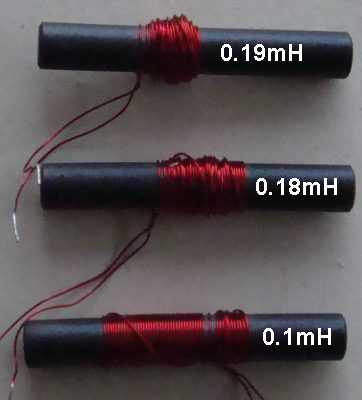
50 turns on 6mm x 40mm
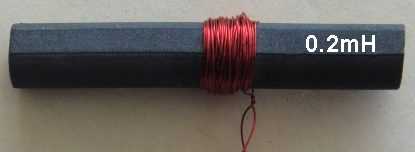
50 turns on 10mm x 40mm
Comparing the 0.19mH rod above with the 0.2mH rod, you can see the diameter of the rod made very little difference to the value of inductance. The properties (quality) of the magnetic material in the rod may have influenced the result.
An inductor has over 20 different uses. We are going to look at some circuits using an inductor.
The “Pi” FILTER
A Pi Filter consists of a capacitor, an inductor (or a resistor) and finally another capacitor.
Each of the three components in this circuit reduces the ripple. The amount of reduction depends on the value of each component.
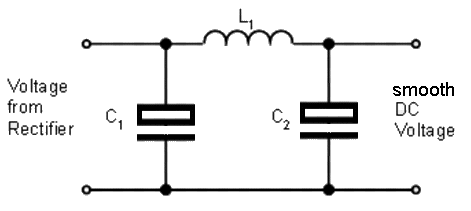
A Pi Filter consists of: capacitor - inductor - capacitor
It can also use: capacitor - resistor- capacitor but a larger voltage-drop will appear across the resistor.
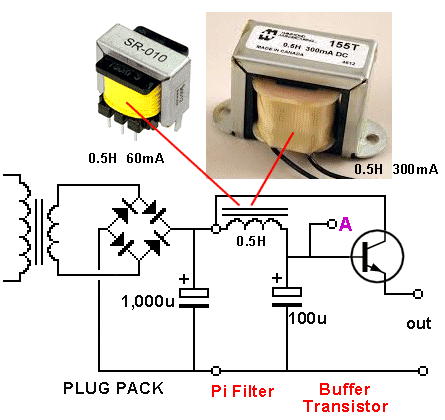
The two capacitors (electrolytics): To understand how a capacitor works, you will have to look on the internet “WALKING ON CUSTARD.”
If you have a swimming pool filled with custard, you can run over the surface and not fall in because the custard resists being “hammered” by your feet. But if you slow down, you will fall in.
That’s how a capacitor works. When a voltage is connected to a capacitor, it charges. If the voltage rises and falls a small amount, the capacitor charges and discharges and it takes time to charge and discharge. This slows down the time the voltage can rise to its original value and it only gets to charge a small amount before the voltage starts to fall again. That’s why the voltage rises and falls LESS than before. This covers both capacitors.
Now we come to the inductor.
We know an inductor allows a steady voltage to pass through without any change.
The voltage being filtered by this circuit consists of a steady voltage with an AC component.
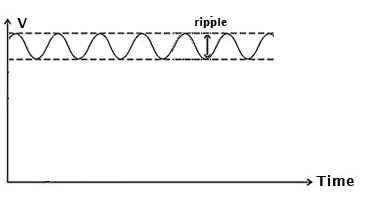
Ripple before Pi Filter
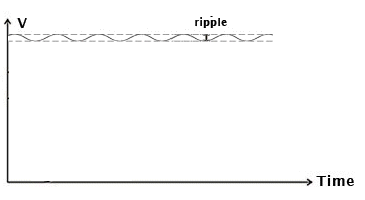
Ripple after Pi Filter
The diagram (graph) shows a voltage with a ripple. The height of the “squiggle” is the amplitude of the ripple. The arrows show the amplitude of the ripple. This ripple is shown on the graph at a height from the “time” line. The time line is also the 0v line and the distance between this line and the ripple is the approximate DC component of the voltage.
The ripple after the Pi Filter will be very small as shown in the second graph.
The steady voltage is called the DC component and this is not altered by any of the three components in this filter.
It is the ripple (the AC component) that produces the expanding and collapsing magnetic flux and when this ripple enters the inductor it produces magnetic flux and this flux cuts all the other turns to produce a voltage in the opposite direction.
This magnetic flux absorbs some of the energy contained in the voltage and this reduces the height of the peak.
This reduces the peak portion of the ripple.
When the ripple drops to a lower value, a point is reached where it cannot produce any flux and the flux stored in the core of the inductor starts to collapse and produces a voltage in the turns that increases the voltage flowing through the inductor and thus the emerging voltage is slightly higher than the original lowest value.
This increases the trough portion of the ripple.
In other words it “smoothes out” the peaks (highest points) and troughs (lowest points) by taking some of the voltage from the peak and adding it to the lowest value via the energy in the magnetic flux.
This type of filter is very effective in reducing ripple, but it is large compared to other forms of filters and the inductors are expensive.
The INDUCTOR AS A SEPARATOR
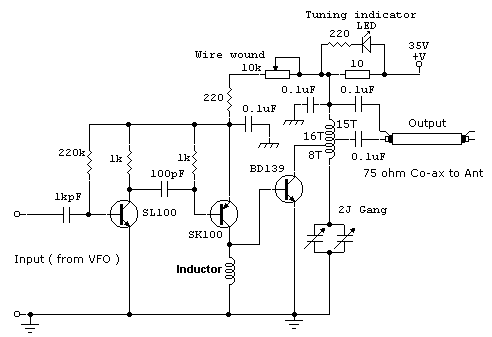
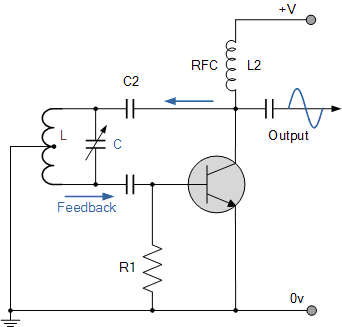
Finally we have the inductor as a SEPARATOR.
When an inductor is used in a circuit as shown above, it is commonly called a CHOKE. This is really to emphasize the fact that the signal does not pass through the inductor - in this circuit.
It allows DC to pass (called the current in the circuit) but prevents AC (called the signal in the circuit).
The inductor has a very small resistance and it allows current to flow through it so the transistor stage works very successfully.
The transistor is amplifying a signal and the signal emerges from the collector in the first circuit and the emitter in the second circuit.
If the inductor was a resistor of very small resistance, the transistor would have to be turned on via large amount of base current to achieve the bottom part of the waveform.
If the resistor is a large value, the transistor will not get sufficient base current to produce a waveform. This is because the collector voltage will drop very quickly and rob the base from getting a voltage and current - the transistor will not get turned ON and only the top of the waveform will be produced.
However the inductor has a very small resistance and it allows current to flow through it so the transistor stage works very successfully.
Here’s how it works:
Normally, when the transistor turns ON, and the load is a resistor, the resistance across the collector-emitter terminals decreases and the current increases.
The increasing current through the load resistor produces a high voltage-drop and this is how the lower part of the waveform is generated.
When the load-resistor is replaced by an inductor, the transistor turns on more and a higher current flows through the inductor.
This produces more magnetic flux and a higher voltage is produced by the inductor and this voltage lowers the voltage on the collector.
In other words, a voltage is produced across the inductor, just like a voltage is produced across a load resistor.
In both cases VOLTAGES are produced due to the current flowing, but the inductor produces the voltage due to magnetic flux and the resistor produces voltage due to Ohms Law.
What is the advantage of the inductor?
It takes less “effort” for the transistor to turn ON fully.
The inductor finds it very easy to produce a voltage that “pushes” the collector away from the positive rail and this is how the waveform is produced. It may even be responsible for producing a larger waveform - depending on the circuit.
The inductor also has a “smoothness” about how it delivers the voltage and this helps to produce a clean waveform.
In some circuits it improves the performance enormously.
Here is an animation of an inductor and transistor.
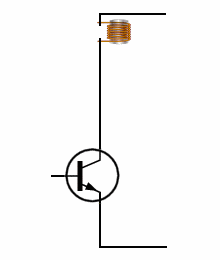
The transistor is turned ON more and more via the base.
This makes more current flow through the collector-emitter terminals and we have shown this by the transistor getting smaller and smaller.
This causes more current to flow through the inductor and the increased current makes more flux.
The additional flux cuts all the turns of the coil and creates a voltage in each turn that is opposite to the applied voltage and a negative voltage appears on the lower lead of the inductor.
This puts a lower voltage on the collector and it is easier for the transistor to turn ON harder.
Increasing the current into the base does not turn the transistor ON an equal amount because the gain of the transistor reduces as it gets turned ON more and more.
This causes the inductor to produce a varying output voltage and the result is a waveform that is curved, similar to a sinewave.
The main point to understand is this:
The inductor makes it easier for the transistor to produce a waveform and it improves the shape of the waveform.
2 CIRCUITS
Here are 2 circuits using the features of an inductor we have mentioned above.
Here’s the feature:
When an alternating signal is presented to one of the terminals of an inductor, it produces a voltage equal to the incoming voltage.
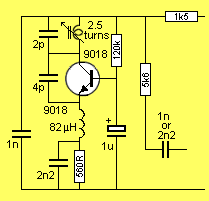
The signal we are talking about comes from the collector and into the emitter via the 4p.
The inductor allows the signal from the collector to pass to the top of the inductor via the 4p capacitor and then into the emitter of the transistor.
The inductor allows the signal to rise and fall very easily and this makes the voltage on the emitter rise and fall.
It is not easy making the emitter rise and fall and that is another topic for discussion.
The base is firmly fixed via the 1u and when the emitter rises and falls, the collector-emitter current rises and falls and this produces the waveform in the 2.5 turn coil.
The bottom of the inductor is held firm via the 2n2 and the 560R is a current-limiting resistor to only allow a small current to flow in the circuit. If too much current flows, the transistor gets swamped and overheats.
The inductor does two things. It allows the signal to pass from the 4p to the emitter and it has a very low resistance so that only a very small DC voltage appears across it. We have already created a large voltage across the 560R and we don’t have any more voltage available, otherwise the voltage for the transistor will be so small that the output waveform from the transistor will be very small. The inclusion of the inductor and the 2n2 allows the transistor to produce a large output. It is really only a few millivolts but it is amplifying the microvolts from the air.
The inductor can be replaced with a resistor and two things will happen.
Some of the signal from the 4p will be lost in the resistor and a voltage will appear across the resistor and this will reduce the output amplitude of the stage.
The value of the inductor is quite critical and it consists of about 70 turns.
It improves the sensitivity of the circuit about 25%. A 60 turn or 80 turn coil will give very poor results - it must be 70 turns for this particular circuit. The actual number of turns depends on the frequency and can only really be determined by experimentation.
.gif)
This circuit uses an inductor at the front-end to improve the sensitivity.
It looks like the coil is a short-circuit to the signal, but it forms a very simple parallel circuit with the 470p that collects all the signals and uses the energy to produce some signals with a higher amplitude. This makes the circuit much more sensitive.
MANY TYPES OF INDUCTORS
There are thousands of different inductors on the market and many more that have been made especially for a particular application.
You cannot look at an inductor and work out its features.
Here’s why:
An inductor has a value called its inductance and this is usually marked via colour bands or written on the component. You can measure this value in an INDUCTANCE METER. The meter sends a pulse through the coil and measures result. But this is not a “real circuit” evaluation. The inductor may react differently in an actual circuit.
And there is another “hidden” value and this is its ability to work at high frequencies. This feature depends on the type of material used in the core. Air cores work to the highest frequency.
The “Quality Factor of air is “1.” Some materials have a “Quality Factor of 100 or more and this means the coil is one hundred times better than and air cored inductor.
Basically the Quality Factor means the inductor will produce a back voltage 100 times greater than the supply voltage during a particular test.
As the frequency of testing increases, the back voltage decreases and at some point the voltage is the same as the input voltage. This becomes the FT of the material and it is no better than an air inductor.
The Quality Factor is often shortened to “Q.”
Another factor that you have to be aware of is CURRENT CAPABILITY.
One inductor can be wound with fine wire and have a high resistance. Another inductor can be wound with thicker wire and have the same inductance.
But the second inductor will not work in the same circuit because the circuit is sensitive to the value of resistance.
In addition, inductors can have different “Q” values. Some inductors are called “High-Q” inductors and these are suitable for connecting across a capacitor to make a circuit called a RESONANT CIRCUIT that produces a high voltage at a particular frequency. It can also be called a TANK CIRCUIT when used in Radio Frequency circuits.
HOW THE INDUCTOR WORKS
Here is a very simple way of explaining how the INDUCTOR works. An INDUCTOR is simply a coil of wire on a cardboard tube or wound on a metal core.
It is an electrical component but suppose we explain it as a mechanical item.
Suppose we connect one end to a wall and turn it into a lever. If we lift the lever, the lever reacts by lifting itself at the same time. This makes it very easy to lift the lever.
This is how an inductor reacts to a rising voltage. If one end of the inductor is tied to the wall, the voltage on the other end rises at the same rate as the voltage you are applying. This makes it very easy for the incoming voltage to rise.
If we replace the inductor with a resistor, it is like using a lever made out of a thick piece of rubber. To raise the lever we need to stretch the rubber and this is hard to do. The rubber does not assist the incoming voltage and tends to work against it.
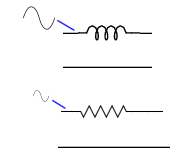
Basically, a waveform trying to enter an inductor will have a higher amplitude than the same waveform trying to enter a resistor. The inductor will be producing a back-voltage that will help the waveform because it will not allow as much current to enter the inductor and this will not reduce the amplitude as much as the resistor shown in the second diagram.
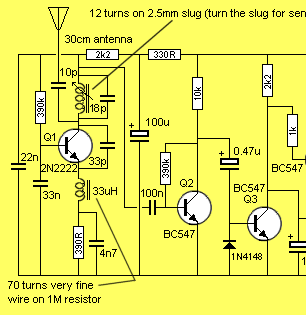
27MHz receiver
Now that we have explained how an inductor works, we can explain the 33uH in the circuit above.
The circuit operates at 27MHz and the first transistor is actually oscillating all the time, even though the circuit is a receiver.
This is the clever part of how this type of circuit works.
The fist transistor is oscillating at a very low level and it is sending out a signal on the receiving antenna.
When it picks up a signal with exactly the same frequency, the two signals interfere with each other and the transistor takes more current and less current at a much lower frequency called the audio frequency.
This clever idea has been introduced because it is much easier to control an oscillator that is already oscillating that try to start up an oscillator circuit.
Now we come to the purpose of the 33uH.
The first thing to remember is this: A capacitor has a very big effect on blocking or passing a frequency that is a HIGH FREQUENCY. It will either block or pass the frequency, depending on where the capacitor is located in the circuit.
And the same thing applies to an INDUCTOR. Its effectiveness will be very high when the frequency s very HIGH.
That’s why the value of a capacitor or inductor can be quite small. Even a low value will have a noticeable effect.
In the circuit above, the 4n7 will have an effective resistance of less than 2 ohms at 27MHz, so the bottom lead of the 33uH will be effectively connected to the 0v rail, as far as the transistor is concerned.
Now we come to the transistor. There are two ways to turn ON a transistor. One is to keep the emitter fixed and increase the voltage on the base and the other is to keep the base fixed and reduce the voltage on the emitter.
We have kept the base fixed. The 33n on the base prevents the base moving.
This means, to turn ON the transistor, we must reduce the voltage on the emitter.
As mentioned above, the transistor is oscillating all the time at 27MHz. This frequency is determined by the top 12 turn coil and the 18p capacitor. These two components form a parallel tuned circuit and the transistor is initially turned on by the biasing components and the 390k on the base.
The tuned circuit creates a sinewave and during the production of the complete cycle of the sinewave the transistor is turned on and off.
The tuned circuit does this by delivering a pulse to the base via the 33p capacitor and when a negative pulse is delivered to the emitter via the capacitor, the transistor is turned ON more. When a positive pulse is delivered, the transistor is turned OFF more.
But what we want to emphasize in this discussion is the action of the 33uH inductor. When the pulse is delivered by the 33p, the inductor “meets” this pulse (amplitude) and produces a voltage of equal amplitude and this has the effect of not reducing the amplitude. This means the full amplitude can be applied to the emitter where it has the greatest effect on either increasing or reducing the voltage.
If the inductor is replaced with a resistor, some of the energy from the pulse will be absorbed by the resistor and the sensitivity of the circuit will be reduced.
In fact, the impedance of the inductor is so critical that a few turns more or less will reduce the performance by 10% or more.
THE RESONANT CIRCUIT - also called the TANK CIRCUIT
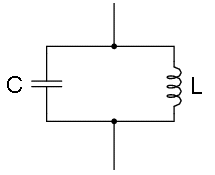
The Capacitor is classified as a PASSIVE COMPONENT because it does not amplify.
The Inductor is classified as a PASSIVE COMPONENT because it does not amplify.
But when these two components are connected across each other, an amazing thing happens.
This amazing thing was detected in the early days when scientists were demonstrating coils and capacitors and creating sparks with batteries and wires.
When the coil and capacitor were placed in parallel, the sparks increased in size and after further experimenting the scientist found the circuit worked best at a particular frequency.
This was years before radio and the scientists though the circuit stored energy and released it at a particular frequency.
When radio transmission came along, this circuit was used to increase the output on a particular frequency and the name TANK CIRCUIT was given to the combination. 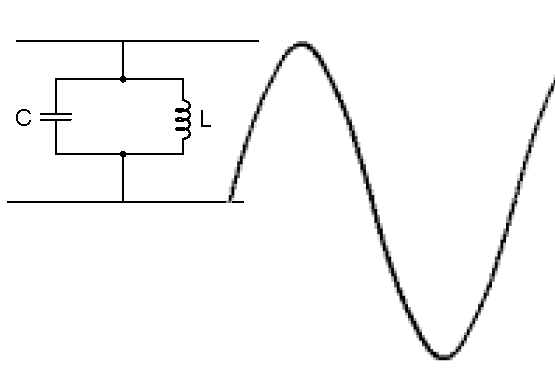
The diagram above shows a TANK CIRCUIT - A RESONANT CIRCUIT that oscillates at a particular frequency, determined by the value of C and L.
Not only does it oscillate and produce a beautiful sinewave output, but the wave is TWICE the voltage of the supply.
To see how it works, we very briefly connect a voltage.
The capacitor charges to full rail voltage and the inductor sees this voltage and produces a back voltage that opposes the voltage and it produces very little magnetic flux.
The supply is now removed.
The capacitor now delivers its energy to the inductor and the inductor produces a back voltage. If the energy tries to be delivered too fast, the back voltage increases and slows down the process.
This is how the shape of the waveform is produced.
A point is reached where the energy from the capacitor is not enough to maintain the flux in the inductor and it starts to collapse and produce a voltage in the opposite direction.
This charges the capacitor IN THE OPPOSITE DIRECTION and that’s how the waveform below the bottom rail is generated.
This action will occur a few more times, but each time the amplitude of the sinewave gets smaller.
When these two components are connected to a circuit, they send out a signal so they are injected with a small amount of energy to maintain the exact same frequency of operation.
That’s why this circuit is called a TUNED CIRCUIT, because it is TUNED or SET or ADJUSTED to operate at a particular frequency. It is these two components that set the frequency. The transistor driving the two components simply injects a small amount of energy at the appropriate time to keep them OSCILLATING.
The end result is the waveform is TWICE the voltage of the supply. In other words, the circuit has amplified the voltage of the supply.
This is what they have done:
They have turned pulses of energy from a transistor into a very smooth sinewave.
They have “controlled” the transistor and set the frequency of operation.
They have produced a sinewave that is double the voltage of the supply.
8R SPEAKER Vs 50R SPEAKER
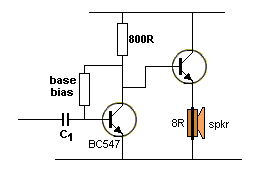
A speaker is an inductor.
Most of the speakers used in transistor radios have an impedance (resistance) of 8R for the VOICE COIL. This has been chosen because it is very easy and cheap to produce. The wire in the coil is also quite thick and robust.
But it is interesting to note that speakers with a high resistance voice coil will produce an equal volume and require less driving current. This applies to 33R speakers as well as 50R speakers.
The reason is this:
Moving the cone requires a certain amount of flux and this can be produced by a small number of turns and a high current or a large number of turns and a low current.
The flux is a product of turns x current and this is called AMP-TURNS. In other words, AMPS x TURNS (number of turns in the coil of wire). A speaker is a LINEAR ACTUATOR and the principle of AMP-TURNS can be applied when designing one of these devices.
Other, closely related devices include the ELECTROMAGNET - for picking up scrap steel, DOOR RELEASE - for unlocking a door, LINEAR MOTOR - for high speed trains and levitation, and the electric motor - such as the 3-pole motor (or 5 pole etc).
And there are dozens of other devices that use a coil of wire that has INDUCTANCE, for an application that uses (makes use of) the magnetic flux produced.
Sometimes the inductance comes into the calculation because it limits the frequency at which the device will operate.
This topic can become very complicated.
The simplest of all electrical devices - a coil of wire - has the largest number of applications in electrical circuits and electronic circuits - and requires some of the most complex theory to understand.
HIGH-VOLTAGE - FLYBACK
All the circuits above are “controlled.” By this we mean the waveform is rising and falling at a known rate.
In these conditions, the output from the inductor will be slightly less than than the incoming voltage.
If the voltage was the same, there would be no resulting input voltage and no current would flow and no flux would be produced.
But if the incoming voltage is turned off instantly, the magnetic flux collapses very quickly and the voltage produced by the inductor can be 10 times to 1,000 times greater than the supply.
This is called a FLYBACK VOLTAGE and there is a whole range of circuits using this feature.
That’s why you have to “see” a circuit working to be able to work out what is happening.
RECAPPING
A coil of wire on a former is called a SOLENOID or ELECTROMAGNET or INDUCTOR. It can also be called a CHOKE.
When there are two separate windings it is called a TRANSFORMER. (or the two winding can be joined in the middle and it is still called a transformer - an AUTO TRANSFORMER).
A FORMER is a cardboard or plastic tube and it can be AIR CORED - nothing in the middle.
A metal rod in the middle is called a CORE. It can be a nail, brass screw, iron rod, ferrite rod, ferrite core, steel, or thin sheets called LAMINATIONS.
All these materials have a different effect and different result on the inductance of the coil and some of the results will surprise you.
When a voltage is applied to an inductor, current starts to flow and this produces magnetic flux that cuts all the turns of the coil to produce a BACK VOLTAGE called BACK EMF.
This “pushes against” the incoming voltage and the result is only a small incoming voltage is available. This small voltage only allows a small current to flow and that’s why it takes a long time (microseconds) to get the full current to flow.
When the full current flows, the back voltage is not produced but the inductor is producing the maximum magnet flux.
When the supply is turned OFF, this magnetic flux collapses and cuts all the turns of the coil and because there is nothing opposing this voltage, and the resulting voltage is ENORMOUS.
It can be 10 times to 1,000 times larger than the supply and this is the “zap” you get when you hold the ends of the coil in your fingers.
This voltage has a polarity that is OPPOSITE to the voltage of the supply.
The INDUCTANCE of a coil is measured in Henries, milli-Henries or micro-Henries.
The colour bands on an inductor are in microHenries.
The numbers on a surface mount inductor are micro-Henries.
The numbers on other inductors are micro-Henries. It is always microHenries.
Such as 104 = 100,000 micro-henries = 10 milli-Henries. See our other article on the INDUCTOR.
Here is a colour code calculator from the web:
http://www.electronics2000.co.uk/calc/inductor-code-calculator.php
Here is a colour code calculator for Resistors, Inductors and other things:
If you found this calculator useful why not download Electronics Assistant?
- All the online calculators and more in a stand-alone application
- Converts Resistor & Inductor colour codes, calculates LED series resistors, capacitance units, series / parallel resistors & capacitors, frequency, reactance & more
- Calculation of nearest preferred resistor values with a choice of 5 series from E12 to E192
- Print & save calculation results
Click here to download Electronics Assistant FREE!
MAKING YOUR OWN INDUCTOR
Making an inductor is very complex and using a formula will only cause frustration.
Here is the only way to design your own inductor:
Go to eBay (and also try electronic parts suppliers) and buy a whole range of inductors and test them in the circuit you are designing.
The material of the core as well as the current capability of the inductor is also important - so the size of the wire may be one of the things you have to consider.
If it works perfectly, use it. Make sure it does not get hot.
If you want to change the inductance slightly, you can remove the heatshrink and remove some of the turns.
If you want to know the value of inductance, buy an inductance tester from eBay for $15.00.
It tests resistors, capacitors, inductors and electrolytics.
You can increase the inductance by adding turns, but it is much easier to remove turns from a larger inductance.
Only remove a few turns at a time.
When you have finished you can count the turns but you must get the same core to achieve the same inductance.
SELF INDUCTANCE AND MUTUAL INDUCTANCE
These two terns sound complex but they simply mean:
SELF INDUCTANCE refers to the inductance of a single coil with a single winding. It can have one turn or a million turns. It just has to be a winding with a single wire at the start and a single wire at the end.
MUTUAL INDUCTANCE refers to an inductor with 2 windings (or 3 or more) where one winding is being supplied with a waveform and the magnetic flux is passing to the other winding and producing a waveform. An example is a transformer.
THE MOTOR
Question: Why doesn’t a 3-pole motor work when the permanent magnets are replaced with curved pieces of steel?
Read this article and you will find out why.
A 3-pole DC motor is the simplest example of an INDUCTOR PRODUCING WORK.
The armature of the motor consists of three inductors and we call these ELECTROMAGNETS.
In this case we also refer to them as POLES.
Here is an animation of a 3-pole DC motor:
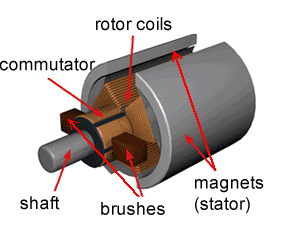
Here is an animation of the armature:
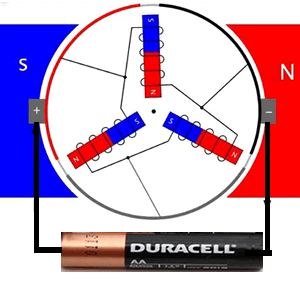
But there is one thing missing from the animation above.
It does not show the fact that one of the poles is connected directly across the battery and the other two poles are in series.
This means one pole will produce a much higher magnetism and it will have the greatest effect on the direction of movement of the armature.
Here are two images of the armature with the main pole (the pole that is directly across the battery) enlarged, so you can see how and why it has the major effect.
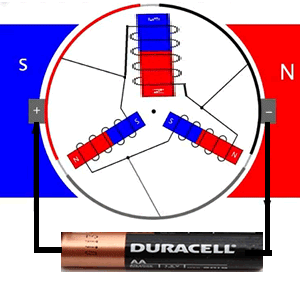
The first fact to understand is this:
An electromagnet only has a pulling or pushing effect when it is AWAY from the permanent magnet.
Un-like poles ATTRACT.
Like pole REPEL.
This means the top pole is being pushed away from the South magnet and pulled towards the North magnet. But it is a long way from each of these poles and thus it will not provide a large amount of “twisting effect.”
The two lower poles are also assisting in the clockwise rotation but will have a small effect too because they are in series across the battery and half the current will flow through them because the resistance of the two poles in series is double the single pole. But the addition of the three effects will provide torque in the clockwise direction to create a torque called a STARTING TORQUE or STALLED TORQUE. This is very high for electric motors because the current is large and thus the magnetic flux is a maximum.
That’s why electric motors are used in lifts, cranes and the fastest 1/4 mile cars and motor bikes.
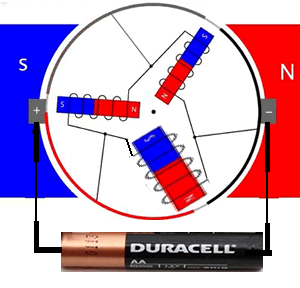
In this diagram the main pole is the lower pole and the top pole is assisting but the pole on the left has no effect.
As a pole rotates, it produces a varying amount of torque and the same applies to the other two poles.
During one complete revolution, the 3 poles are contributing varying amounts of torque and all this produces a fairly smooth rotation and the final result is a CONSTANT.
Each pole changes from North to South during every revolution and the magnetic flux in the poles also travels from one pole to the other through the centre of the armature to assist the magnetism produced by the two weaker poles.
But there is a lot more to understanding the operation of a motor.
A motor is also a GENERATOR.
Even though each pole is receiving a voltage and a current is flowing through the winding, the mere action of the armature rotating means the effect of the magnetic flux from the permanent magnet is increasing and decreasing as the armature rotates. The effect changes because the distance been the permanent magnet and the face of the pole is increasing and decreasing.
This magnetic flux is interacting with the flux produced by the pole.
We will take a very simple case to show what we mean.
When the outer surface of a pole is producing a NORTH pole we say the flux is emerging from the pole.
If this pole is moving towards a NORTH permanent magnet, the effect of the magnetism from the permanent magnet is INCREASING.
This means that basically the flux produced by the current flowing through the pole is called NORTH POLE FLUX and is a CONSTANT and flowing out of the pole while the flux entering the pole is also NORTH POLE FLUX and is increasing.
These two fluxes FIGHT EACH OTHER and to make it easy to understand, the flux entering the pole cuts the turns of wire on the pole and produces a voltage in the winding that is in the opposite direction to the voltage of the battery.
This voltage can be as high as 99% of the battery voltage and the end result is only say about 0.1v is available for the pole. But to be more realistic, say 90%. When this voltage is about 90% of the original voltage, only about 10% of the original current flows when the armature is rotating at a high RPM (revolutions per minute).
When you load the motor by holding the shaft with your fingers, the RPM reduces and the voltage produced by permanent magnet will reduce because the flux it produces will not be increasing at the same rate. It’s the speed of the increase in voltage that produces the higher voltage. If you move the pole-face closer to the permanent very slowly, the back-voltage will be very small. If you move it closer, VERY QUICKLY the back-voltage will be much higher.
The strength of a motor is called TORQUE and this is the twisting or turning capability of the shaft.
The torque depends on many factors and the most important factor is the strength of the permanent magnets.
If the magnets are very weak, the RPM of the armature will be very high.
The RPM of a motor increases and increases until the energy delivered by the battery is just enough to keep the armature spinning.
As the RPM of the motor increases, the back-voltage produced by the armature increases and this effect reduces the current and a point is reached where the energy entering the motor is just enough to maintain a certain RPM.
If you increase the strength of the magnets, the flux they produce will increase the back-voltage at a lower RPM.
The energy required by the motor increases as the RPM increases and as the RPM increases, it produces a higher back-voltage and this reduces the current into the motor. That’s how we get a final RPM.
So the RPM gets to a point where the motor is actually sending out a signal that reduces the input current and this creates the final RPM.
Now, here’s another secret.
You can see the armature is rotated by a combination of repulsion and attraction.
Suppose you have a solenoid and a flat piece of steel. If the end of the solenoid is NORTH, the steel is attracted. If the solenoid is SOUTH, the steel is attracted. In other words, you can only get a repulsion when the steel is replaced by a magnet. And the effect of repulsion is determined by the strength of the magnet. That’s why you need strong permanent magnets in a motor. Not for the attraction-effect but for the repulsion-effect. Where has this ever been explained in any text book???
Another very important point to understand is called an AIR GAP.
There must be a gap between the outer surface of the pole and the permanent magnet to allow the armature to rotate.
This gap must be as small as possible because the flow of magnetic flux through the air is one thousand time less than through the metal making up the core of the pole.
You can prove this by taking an electromagnet and bringing it up close to a sheet of metal and then removing it. Then let the magnet touch the sheet of metal and you will not be able to remove it.
This is how a MAGNETIC LOCK works in a jail. Put a thick piece of cardboard between the two faces and the magnetic lock will have no “holding strength” and you will be ready to break out during the night!!!
With a motor, the strength of the magnets is important and the gap must be as small as possible.
You can get some idea of the torque of a motor by turning the shaft with your fingers and detecting how hard it is to turn when no battery is connected. You are detecting the strength of the permanent magnets with the magnetic material of the pole face.
A 3-pole motor will have 6 “spots” on every revolution.
These are all very important points to understand and some very clever engineers have realised the limitations of the simple 3-pole motor and produced improvements.
The 3-pole motor is very inefficient and, in fact, all motors are very inefficient because the magnetic flux is not pulling or pushing directly at 90 degrees to the surface of the permanent magnet. If we take the case of a pole being pushed away from the face of a permanent magnet, the action of pushing is sometimes directly in line with the shaft and this provides no “leverage” or rotational force.
The forces or actions we are talking about can be clearly seen in a STEAM ENGINE.
The linear action of the piston is converted to rotary action by the linkages. The magnetic flux is the linear piston and the face of the pole is the length of the pole and the shaft is the linkage.
This discussion could extend to a whole book but it is important to know the number of turns on each pole and the thickness of the wire is determined by trial and error.
Firstly you select thick enamelled wire and see how many turns you can get on each pole to fill the pole-space.
Assemble the motor and connect to a 6v battery.
Test the unloaded RPM and the stalled torque, the stalled current and the unloaded current. Put the values in a table.
Choose a thinner wire and then a very thin wire and then a thicker wire and a very thick wire. You will have 5 sets of results.
To help you understand the results, remember this: the magnetic flux produced by each pole is due to the AMP-TURNS of the winding. In other words, the same flux will be produced by 50 turns @ 1 amp or 10 turns @ 5 amp.
When you reduce the number of turns, the RPM of the motor will increase because the motor has to spin faster to produce the “back voltage” so the current reduces to a level necessary to keep the motor spinning.
If you want a motor to take a lot of current, you need very few turns. This will also give the motor a very high terminal RPM.
AC MOTOR
If you want a 3-pole AC motor, the permanent magnets must be replaced with a single winding with North on one side of the motor and South on the other side.
You can connect the armature and field winding in parallel or series. It does not matter at the moment.
When the AC is connected, the 3 pole-faces will be producing North and South as shown in any of the diagram above and when the AC reverses, the pole faces will reverse too and exactly the same attraction and repulsion forces will apply because both items are changing at the same time. The frequency of the AC has no bearing on the RPM of the motor.
However if you put the armature and field in SERIES, the motor RPM will increase to a higher value than before because as the RPM increase, the current taken by the motor will decrease and the magnetism produced by the field winding will reduce and the armature will need to pass the field poles quicker to produce the necessary back-voltage.
When you turn the motor ON, it takes a lot of current (too much current) and this gives the armature a lot of energy and the motor increases in RPM. As it does, the armature passes the field magnet and the magnetism from the field creates a back voltage in each pole.
So we have a voltage going into the motor and a back-voltage produced by the motor. This effectively reduces the incoming voltage and the lower voltage causes a lower current to flow. This current reduces and reduces until it is just enough to spin the motor at the terminal RPM.
Quick Links
Legal Stuff
Social Media



